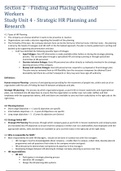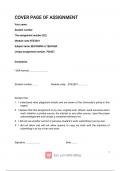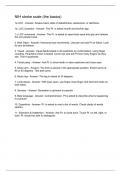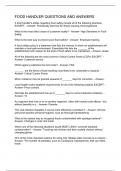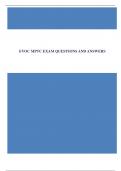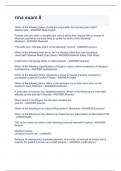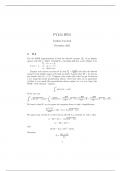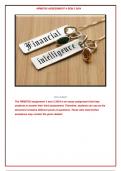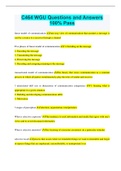Workers
Study Unit 4 - Strategic HR Planning and
Research
4.1 Types of HR Planning
The company can choose whether it wants to be proactive or reactive.
Organisations can make a decision regarding the breadth of the planning.
The formality of the plan. the company decision here can be the formal or informal route. Informal route - the planning
is done by the heads of managers and HR staff. In the formalised approach, the plan is clearly spelled out in writing and
backed up by supporting documentation and data.
o Craft has identified the following possible types of linkages:
Input linkages. Here HR information is made available either before or during the strategic planning
process. This can take place through a specialised HR unit doing scanning or through specialised
Committee of HR personnel.
Decision inclusion linkages. Here HR personnel are either directly or indirectly involved in the strategic
planning process of the company.
Review and reaction linkages. Here HR personnel can respond to a proposed or final strategic plan.
The plan may be reviewed from an HR flexibility (can the necessary manpower be obtained?) and
desirability (will there be a strike?) viewpoint or they may even have sign-off authority.
Definitions:
Human resource Planning – process of anticipating and providing for the movement of people into, within and out of an
organization with the aim of finding the best fit between employees and jobs.
Strategic HR planning – the process by which organizational goals, as put forth in mission statements and organizational
plans, are translated into HR objectives to ensure that the organization is neither over-not under staffed, and that
employees with the appropriate talents, skills and desire are available to carry out their tasks/duties in the right jobs at the
right times.
4.2 Planning Horizon
Short range Objectives = < 1 year & objectives are specific
Intermediate objectives = 2 – 4 years & Objectives are specific
Long range objectives = 5 - 15 years & objectives are General
4.3 Strategy-linked HRP
Strategic HR Planning The process through which company goals as put forth in mission statements and company plans
are translated into HR objectives to ensure that the company’s neither over nor understaffed, that employees with the
appropriate talents, skills and desire are available to carry out their tasks in the right jobs at the right times.
4.4 Who is responsible for SHRP?
Main responsibility lies with HR Managers, should not be done in isolation but with line managers
o HR managers must be knowledgeable about company – enable them to analyse, collect data, develop plans &
programmes and ask questions that relate to the company mission and goals
o HR professional to demonstrate competence & expertise to line managers
o Developing linkages between HR planning & strategic company planning as process over time.
HR responsibilities:
o HR Unit
Participates in strategic planning process
Identifies HR strategies
Design the HR planning data systems
, Compiles and analyses data from managers on staffing needs
Implements the HR plan as approved by top management
o Line Managers:
Identify supply and demand needs for each division/department
Review/discuss HR planning information with HR specialists
Integrate the HR plan with departmental plans
Monitor the HR plan to identify changes needed
Review employee succession plans associated with the HR plan.
4.5 Why Is SHRP so Important
Strategic change refers to major transformations in the structure, size or functioning of an organisation for the purpose
of achieving strategic objectives.
4.6 Elements of SHRP
HR Objectives – objectives for change state what is to be achieved with regard to the firm's human resources.
Objectives may be stated in both quantitative and qualitative terms: when specifying objectives it is important to
also indicate who is responsible for making the needed changes.
HR Plans – can be thought of as blueprints for action. They specify who needs to do what, when, where & how
4.7 Steps In the SHRP Process
Step 1: Establishment of the mission and vision and values
4.8
Step 2: external analysis
o Monitor and assess the company mission & core business
o Conduct environment scanning to gather info about trend and anticipated developments in external &
internal environments
Step 3: Conduct an internal analysis:
o Organization, determine what needs to change and improve and what it is doing well and thus should keep
on doing.
Step 4 : Forecasting demand
o The determination of total manpower requirements of company
o Types, skills &location of employees must be determined
o Analyse past trends & productivity then linking company plans to productivity levels and projecting future
needs
Step 5 : Forecasting Supply
o Entails evaluation of future supply of labour (internal & external)
Step 6 : Strategy Development/Formulation
Step 7 : Succession Planning – the process of identifying a longer-term plan for the orderly replacement of key
employees
1. Methods of forecasting HR Supply and Demand
Quantitative
Moving average – averages data about HR demand from recent periods and projects them into the
future
Exponential smoothing – forecasters can vary weights for HR demand assigned to different past time
periods used to project future HR demand
Trend projection – numbers of people hired or placed on one axis, time is placed on the other axis,
straight line is plotted from past to future to predict HR demand
Regression – mathematical formula used to relate staffing to several variables
Linear programming – assess required staffing levels that matches desired output level – subject to
certain constraints
Actuarial models – Relate turnover to such factors as age and seniority
Simulations – use scenarios to test the effect on various personnel policies
Probability matrixes – define “states” in the organisation – such as strategy levels, performance
ratings and identifies time periods
, First-order Markov model – multiply number of people in each job category by the probability of
movement between jobs. The model assumes that the current job/position category is the chief
determinant of movement
Semi-Markov Model – Same as first order markov model except for - probability of movement
determined by a) job / position category b) the individual’s length of stay in the job class
Qualitative
Delphi Technique – group of experts exchange several rounds of estimates of HR demands or supply,
without meeting face to face. Feedback from other experts is used by each individual to “fine tune”
their independent results.
Nominal Group Technique – a small group of experts meet face to face. Following a procedure that
involves open discussion and private assessment, the group reaches a judgment concerning future
HR demand and supply.
4.9 Common pitfalls in SHRP
The Identity Crisis – HR planners must develop strong sense of mission (direction) or their existence might be
challenged
Top Management Support – it must have the full support of management, not always forthcoming.
Size of effort – programmes fail in beginning due to complex start, better to start with basic rather than complex
system.
Coordination with Other Functions – process must be coordinated with other management & HR functions
Integration with Company plan – HR plans must be derived company plans. Isolation plans will not work
Non-involvement of operating Managers – coordinated efforts between Operating managers & HR staff if not
done, designed / formulated plans will not be implemented by line managers
The technique trap – companies must decide on purpose of activity and obtain/use techniques most suited to
particular need
4.10 HR research and Metrics
HR Research is the collection & investigation of facts related to HR problems in order to eliminate/reduce those problems
Specific uses of HR Research:
Measurement & evaluation of present conditions
Prediction of condition, events & behavioural problems
Evaluation of current policies /programs/activities
Discovery of rational bases for revising current policies/ programs/activities
Appraisal of proposed policies/ programs/activities
Types of research:
Basic (pure research) – done to advance knowledge in particular field or to gather info on given subject e.g
universities, consultants, private – and non-profit institutions
Applied – is done to solve a particular problem, its results might be put to immediate use
The researchers:
Government – many government departments Labour & Human Science Research Counsel (HSRC)
Private organisations – Deloitte& KPMG
Universities –
Business Firms – on going research responsibilities of HR staff include:
o Evaluating T&D programmes
o Conducting periodic wage and salary surveys
o Predicting future HR staffing requirements
o Conducting surveys of employee attitudes
o Performing studies of employee productivity
o Validating selection & testing instructions
o Requests from other departments
Investigation of extreme high employee grievances in particular department
A programme to reduce absenteeism among clerical personnel
Evaluation of changes in a labour-management agreement that may affect productivity
Develop special performance appraisal method for sales personnel
, HR Research publications – it's the most practical & expedient way for HR professionals to keep on top of the research is
by regularly selected group of HR journals & magazines, or subscribing to electronic bulletin boards via the internet
HR Metrics – used to calculate the success or failure of workforce related HR projects, or initiatives related to the HR
function in terms of cost and impact
Human capital Metrics – include the measurement of HR practices, but go further by also looking at other work practices
and people management strategies in general, including the overall strategy of the organization.
4.11 Research techniques –
Important for 2 reasons:
1. The appropriate research technique must be applied to the issue at question as inappropriate techniques may
seriously affect the validity and usefulness
2. A broad knowledge of techniques is needed to read and understand the studies reported by other employers and
researchers
Surveys – employees survey most widely used technique e.g wage- & job satisfaction survey (aka attitude or morale
survey)
o Job satisfaction survey – linked with absenteeism & turn around studies.
Factors contributing to good job satisfaction:
The job itself – the kind of work performed & freedom to determine how work is done
Co-worker relations – the extend of acceptance , friendliness and support by fellow
workers
Good supervision – the perceived attributes of a good supervisor
Opportunity to grow – the chance to develop new skills and climbing the corporate ladder
Factors contributing to negative job satisfaction
Poor supervision – insensitive , incompetent & uncaring supervisors
Interpersonal conflicts – interpersonal conflicts, lack of teamwork unfriendliness
Poor work environment – dirty, noisy, unsafe or unhealthy factors
Poor pay – low, uncompetitive pay
o Specific-use questionnaire – focus on a particular problem or issue, are generally custom-made by members of
Hr staff or outside consultant. Site-specific / specific-use questions are often added to another for more
general use
o Survey Administration - steps to be considered:
Objective – management must identify the objectives of survey
Top Management Commitment – must be willing to share and discuss outcomes with employees
Survey development – developed either internal or external. External is more acceptable
Announcing the Survey – different opinion on this, analyse locally
Implementation – important considerations:
Allow for sufficient time to complete
Rollout survey to all employees at same time
Administer the survey on company premises
Analysis – results can reflect total organisational results in comparison to individual groups.
Feedback – results should be communicated. Most effective is face-to-face
Follow-up – important to ensure good relationships maintained and implemented actions
Caution – results gain meaning by virtue of relevant comparison. Appropriate questions to be selected
Exit interviews: done when persons leaves company voluntary, valuable source of information regarding reason for
leaving, perceptions of supervisor, salary, benefits, training & opportunities of advancement. Must be done by HR and
not direct supervisor
Historical Study – HR researchers track data over time and helps them gain greater insight into Human Behaviour

